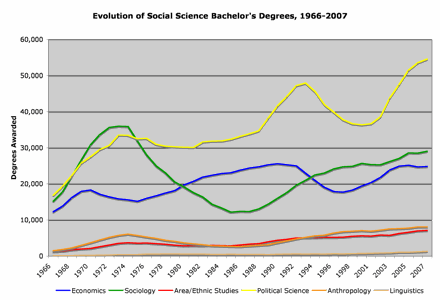To continue this week’s project of elaborating on anthropology’s disciplinary context and structure, let’s see where we fit in relation to the other social sciences in our production of bachelor’s degrees.

As with the more general university situation, all fields have been growing, albeit with a major dip in the mid-seventies to late-eighties, which is again probably due to the Baby Boom ending. It’s obvious that the biggest field by far is political science — though my figures for political science also include public administration, whose more marketable vocational potential may explain the overall predominance of this discipline. Economics and sociology, in blue and green, have been somewhat similar for decades — while sociology was far more popular from the ’60s into the ’70s, economics overtook it between 1980 and 1994, and since then sociology has pulled ahead slightly but not that much. One notices a curious correlation, probably spurious I suppose, between the economics degrees issued and the political party holding the presidency: throughout the Reagan/Bush 1 era, economics is ascending; then it drops substantially under Clinton; then it rises again around when Bush 2 comes into office.
I note in passing that linguistics is absolutely tiny and barely visible (a thin brown line at the bottom of the graph). Our own discipline, anthropology, is pretty low on the charts too; and it also has a very close partner on the graph, which is area and ethnic studies. It turns out, somewhat unexpectedly, that anthropology and ethnic/area studies have been very closely linked in undergraduate enrollments since the 60s. Let’s look at this in more detail.

While larger fields like sociology and economics award tens of thousands of bachelor’s degrees yearly, anthropology and ethnic studies have been climbing up slowly to 7-8,000 degrees awarded per year. One can only speculate that the sort of undergraduates who are interested in anthropology are about equally likely to be interested in area or ethnic studies, which would fit, of course, with the fact that anthropology has long been specialized in teaching about ethnic or foreign Others, and overlaps frequently in its content with the various * Studies departments. I do note one interesting difference, though, which is that the usual dip in degrees awarded (that big local decline starting in 1975) is far more pronounced in anthropology, while ethnic studies fell less far. Might it be the case that ethnic and area studies were gaining in comparative importance in that period because of the growing institutionalization since the 70s of multiculturalist education and programs? What can we learn about the history of the disciplines from these analyses?
When we look at the production of doctorates, things look somewhat different than at the bachelor’s level, but I want to stop here for now to think about the methodological implications of this kind of analysis.